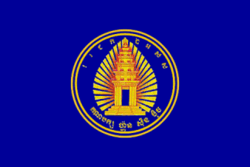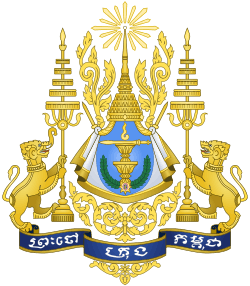Funcinpec Party
| National United Front for an Independent, Neutral, Peaceful, and Cooperative Cambodia | |
|---|---|
|
Front uni national pour un Cambodge indépendant, neutre, pacifique, et coopératif (FUNCINPC) រណសិរ្សបង្រួប បង្រួមជាតិដើម្បីកម្ពុជាឯករាជ្យ អព្យាក្រិត សន្តិភាព និងសហប្រតិបត្តិការ (គណបក្ស ហ្វ៊ុនស៊ិនប៉ិច; Kanakpak) | |
| President | Norodom Ranariddh |
| Secretary-General | Say Hak |
| Founded | 21 March 1981 |
| Headquarters | Phnom Penh, Cambodia |
| Ideology |
Cambodian nationalism Royalism Sihanoukism Conservatism |
| Political position | Centre-right |
| International affiliation | Centrist Democrat International |
| Colors | Blue and Yellow |
| National Assembly |
0 / 123 |
| Senate |
0 / 61 |
| Website | |
|
funcinpecparty | |
|
Politics of Cambodia Political parties Elections | |
FUNCINPEC (Khmer: គណបក្ស ហ្វ៊ុនស៊ិនប៉ិច) is a royalist political party in Cambodia. Before the 2008 election, FUNCINPEC and the Cambodian People's Party formed a coalition government, although FUNCINPEC's significance has decreased steadily since 1998, when it had an equal relationship with the CPP in the coalition. It is currently the third largest party in Cambodia but failed to win any seats in the 2013 elections.
FUNCINPEC is a French acronym for Front uni national pour un Cambodge indépendant, neutre, pacifique, et coopératif, which translates to "National United Front for an Independent, Neutral, Peaceful, and Cooperative Cambodia" (Khmer: រណសិរ្សបង្រួប បង្រួមជាតិដើម្បីកម្ពុជាឯករាជ្យ អព្យាក្រិត សន្តិភាព និងសហប្រតិបត្តិការ).
History
Background
The party traces its roots to Norodom Sihanouk, the Cambodian independence leader, former King of Cambodia, Prime Minister and latterly Head of State during the period between 1955 and 1970, when his Sangkum regime controlled Cambodia. Sihanouk was deposed in a March 1970 coup by his cousin, Prince Sisowath Sirik Matak and rightist General Lon Nol, who proclaimed the Khmer Republic that October. Subsequently, Sihanouk had gone into exile in Beijing, and formed the Royal Government of National Union of Kampuchea (GRUNK), a coalition government incorporating his former enemies, the Communist Party of Kampuchea (or, as Sihanouk referred to them, the Khmer Rouge).
After the communist victory in the Cambodian Civil War in 1975 and their establishment of Democratic Kampuchea, Sihanouk's supporters were sidelined and purged, while Sihanouk himself was placed under effective house arrest. However, when the Vietnamese army expelled the Khmer Rouge in early 1979, Sihanouk (once more in exile) found himself in an ambivalent position regarding the Khmer Rouge: "despite its abuses of human rights, it is the genuine and only government of Cambodia. It sprang from popular resistance to the United States and Lon Nol. If I fought against it, I would be a traitor."[1]
The Khmer Rouge, now realising that Sihanouk's status as a figurehead would help their cause internationally, asked Sihanouk to plead the case of Democratic Kampuchea at the United Nations. Sihanouk now publicly broke with the communists, labelling them mass murderers and demanding that they be expelled.[2]
MOULINAKA
In the period up to 1979, a large number of refugees had gathered in camps on the Thai border, including some armed groups: former Republicans, royalists, remnants of the Khmer National Armed Forces's (FANK)'s 13th Brigade formerly commanded by Norodom Chantaraingsey, and bandits taking advantage of the chaos. In 1979, the numbers were vastly swelled by more refugees and defeated elements of the Khmer Rouge army.
The politician Son Sann and former FANK general Dien Del had already made efforts to organise some of the disparate groups into a resistance Front to fight the Vietnamese presence, which went on to become the Khmer People's National Liberation Front (KPNLF); this was a non-communist and largely republican movement. Two further former officers - naval captain Kong Sileah and paratroop colonel Nhem Sophon - were however to decide that they wanted an organisation with a unified command structure, rather than the KPNLF's loose coalition, and set up the Movement for the National Liberation of Kampuchea (MOULINAKA) on 31 August 1979 to achieve this.[3] This was the first of the resistance groups to pledge its loyalty to Sihanouk. Sophon was to enter Cambodia secretly in order to rally support to the royalist cause; captured by the Vietnamese, he managed to escape in April 1980, and took over sole leadership of MOULINAKA after the death of Kong Sileah from malaria on August 16, 1980.
The formation of FUNCINPEC and the ANS
Sihanouk set up FUNCINPEC in Paris in February 1981, with a central committee of 100 prominent Cambodian exiles.[3] FUNCINPEC was formed, with the encouragement of ASEAN states, in order to provide an alternative resistance against the Vietnamese to that offered by the Khmer Rouge, who were still holding out in the remote north-west and west of the country, and to the loose organisation of the KPNLF, who were broadly favoured by the US and western powers in general. Later that year, Sihanouk recruited the veteran politician In Tam - who had, ironically enough, been one of the main figures behind the 1970 coup - to form FUNCINPEC's armed wing, the Armee Nationale Sihanoukiste (ANS, Sihanoukist National Army). The ANS was accordingly formed with the bulk of its manpower coming from MOULINAKA, the remainder being drawn from the smaller armed groups Khleang Moeung, Sereika Odder Teus, Khmer Angkor, Praloeng Khmer, and Damrei Sar Phluk Khiev.[3]
The CGDK
Throughout 1982 the ASEAN states, concerned about the presence of the Vietnam People's Army (PAVN), in the border areas of Cambodia funneled aid and arms to the KPNLF and ANS through Singapore.[3] The Khmer Rouge's forces, the National Army of Democratic Kampuchea, continued to receive support from China. However the success of the PAVN in clearing the border areas, and military defeats suffered by all three guerrilla groups, led the ASEAN states to apply pressure on the KPNLF, FUNCINPEC and the Khmer Rouge to coordinate their efforts. Despite considerable disagreements, especially between the Khmer Rouge and the KPNLF - Son Sann remaining firmly opposed to any agreement whatsoever - this resulted in the formation of the Coalition Government of Democratic Kampuchea subsequent to the signing of an agreement in Kuala Lumpur in June 1982. Sihanouk, representing FUNCINPEC, was President; Khieu Samphan, representing the Khmer Rouge, Vice-President, and Son Sann Prime Minister.
In the meantime, disagreements between Sihanouk and In Tam led to the latter's removal, and Prince Norodom Ranariddh, one of Sihanouk's sons, took control of the ANS. At this stage the ANS was the smallest of the three armed movements fielded by the three components of the Coalition Government.
The later 1980s
In the late 1980s, prior to the withdrawal of Vietnamese troops and formation of Cambodia's governing political coalition, Son Sann's KPNLF and Sihanouk's ANS drew some military and financial support from the United States, which sought to assist these two movements as part of the Reagan Doctrine effort to counter Soviet and Vietnamese involvement in Cambodia. One of the Reagan Doctrine's principal architects, the Heritage Foundation's Michael Johns, visited with Sonn Sann and ANS forces in Cambodia in 1987, and returned to Washington urging expanded U.S. support for the KPNLF and the Sihanouk resistance forces as a third alternative to both the Vietnamese-installed and supported Cambodian government and the Khmer Rouge, which also was resisting the government.[4] FUNCINPEC and the ANS were also to receive support from China, alongside their existing supply of the Khmer Rouge.
The KPNLF was in the meantime severely damaged by a 1986 split between Son Sann and its military wing, led by General Sak Sutsakhan, one of the favoured candidates of the United States for leadership. A combination of military reversals and the effects of infighting led to its forces falling from around 20,000 to 10,000 by 1987. FUNCINPEC and the ANS, on the other hand, benefiting from its unified structure and Sihanouk's status, began to increase its prominence. The Khmer Rouge expanded from their bases in the Cardamom Mountains to set up at Phnom Malay on the Thai border, while the ANS created a new field headquarters at Tatum.[5] Despite continuing reports of clashes between the Khmer Rouge troops and the ANS, which the Khmer Rouge generally blamed on the Vietnamese, the two groups were able to coordinate operations during 1987, attacking the town of Battambang and arranging joint patrols as far as Phnom Penh.[6]
After the 1991 Peace Settlement

In 1991 FUNCINPEC signed the 1991 Paris Peace Accords. Following the withdrawal of Vietnamese troops from Cambodia, Sihanouk's son, Prince Norodom Ranariddh, served as co-prime minister with Hun Sen from 1993 to 1997, and led the party until October 2006; current leader Keo Puth Rasmey succeeded Ranariddh.
Sihanouk returned to Cambodia, again as King, in 1992. However, despite FUNCINPEC being the largest party in the governing coalition with the Cambodian People's Party, it was disrupted by internal factionalism throughout the early 1990s. The princes who headed the party - Ranariddh, Sihanouk's half-brother Norodom Sirivudh, and Sisowath Sirirath (the son of Sirik Matak, who deposed Sihanouk in the 1970 coup) - disagreed violently over corruption, Vietnam, the Khmer Rouge, land reform, and other issues. In May 1994 Sihanouk despairingly commented "there is a civil war between the Khmer Rouge and royal armed forces, civil war within FUNCINPEC, civil war everywhere".[7] The 1997 clashes in Cambodia, depicted by Ranariddh as a coup by Hun Sen and the CPP - while depicted by Hun Sen as a coup attempt by Ranariddh and FUNCINPEC with Khmer Rouge backing - resulted in Ranariddh going into exile in Paris.
At the 1998 elections to the National Assembly of Cambodia, FUNCINPEC took second place with 43 of 123 seats, establishing the Cambodian People's Party as the leading party in Cambodia. At the 2003 National Assembly elections, the party declined further, taking 20% of the vote and receiving 26 seats. At the 2006 elections to the Senate of Cambodia, the party took 19% of the vote and 12 of the 61 seats. After Norodom Ranariddh was dismissed from the party leadership, he left to form the Norodom Ranariddh Party. FUNCINPEC and the Norodom Ranariddh Party both suffered a massive defeat in the 2008 National Assembly elections, receiving only two seats each. The Cambodian People's Party won a landslide victory, the Sam Rainsy Party became the second largest party and was confirmed as the main opposition party, and even the new Human Rights Party became stronger than FUNCINPEC.
List of party presidents
| Name | Term of office |
|---|---|
| Norodom Sihanouk | 1981–1989 |
| Nhiek Tioulong | 1989–1992 |
| Norodom Ranariddh | 1992–2006 |
| Keo Puth Rasmey | 2006–2011 |
| Nhek Bun Chhay | 2011–2013 |
| Norodom Arunrasmy | 2013–2015 |
| Norodom Ranariddh | 2015-present |
General election results
| Election | Total seats won | Total votes | Share of votes | Outcome of election | Election leader |
|---|---|---|---|---|---|
| 1993 | 58 / 120 |
1,824,188 | 45.5% | |
Norodom Ranariddh |
| 1998 | 43 / 122 |
1,554,405 | 31.7% | |
Norodom Ranariddh |
| 2003 | 26 / 123 |
1,072,313 | 20.8% | |
Norodom Ranariddh |
| 2008 | 2 / 123 |
303,764 | 5.05% | |
Keo Puth Rasmey |
| 2013 | 0 / 123 |
242,413 | 3.66% | |
Norodom Arunrasmey |
References
- ↑ Shawcross, W. Sideshow:Kissinger, Nixon and the Destruction of Cambodia, Simon & Schuster, 1979, p.391
- ↑ Coalition Government of Democratic Kampuchea, Library of Congress Country Studies
- ↑ 3.0 3.1 3.2 3.3 Corfield, J. A History of the Cambodian Non-Communist Resistance 1975-1983, Monash University, 1991, p. 8.
- ↑ "Cambodia at a Crossroads," by Michael Johns, The World and I magazine, February 1988.
- ↑ Radu, M. The New insurgencies: anticommunist guerrillas in the Third World, 1990, p.218
- ↑ Radu, p.220
- ↑ Etcheson, C. After the killing fields: lessons from the Cambodian genocide, 2005, pp.48-49
External links
| |||||||||||||||||||||||||||||||
